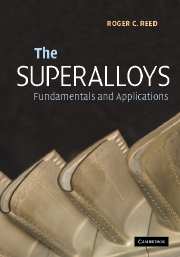Book contents
- Frontmatter
- Contents
- Foreword by Dr Mike Hicks
- Preface
- Acknowledgements
- 1 Introduction
- 2 The physical metallurgy of nickel and its alloys
- 3 Single-crystal superalloys for blade applications
- 4 Superalloys for turbine disc applications
- 5 Environmental degradation: the role of coatings
- 6 Summary and future trends
- Index
1 - Introduction
Published online by Cambridge University Press: 01 September 2009
- Frontmatter
- Contents
- Foreword by Dr Mike Hicks
- Preface
- Acknowledgements
- 1 Introduction
- 2 The physical metallurgy of nickel and its alloys
- 3 Single-crystal superalloys for blade applications
- 4 Superalloys for turbine disc applications
- 5 Environmental degradation: the role of coatings
- 6 Summary and future trends
- Index
Summary
Background: materials for high-temperature applications
Characteristics of high-temperature materials
Certain classes of material possess a remarkable ability to maintain their properties at elevated temperatures. These are the high-temperature materials. Their uses are many and varied, but good examples include the components for turbines, rockets and heat exchangers. For these applications, the performance characteristics are limited by the operating conditions which can be tolerated by the materials used. For example, the thrust and fuel economy displayed by the modern aeroengine is strongly dependent upon, and limited by, the high-temperature strength of the nickel-based superalloys used for its hottest sections.
What are the desirable characteristics of a high-temperature material? The first is an ability to withstand loading at an operating temperature close to its melting point. If the operating temperature is denoted Toper and the melting point Tm, a criterion based upon the homologous temperature τ defined as Toper/Tm is sensible; this should be greater than about 0.6. Thus, a superalloy operating at 1000°C in the vicinity of the melting temperature of nickel, 1455 °C, working at a τ of (1000 + 273)/(1455 + 273) ~ 0.75, is classified as a high-temperature material. But so is ice moving in a glacier field at –10 °C, since τ is 263/273 ~ 0.96, although its temperature is substantially lower. A second characteristic is a substantial resistance to mechanical degradation over extended periods of time.
- Type
- Chapter
- Information
- The SuperalloysFundamentals and Applications, pp. 1 - 32Publisher: Cambridge University PressPrint publication year: 2006
- 18
- Cited by



